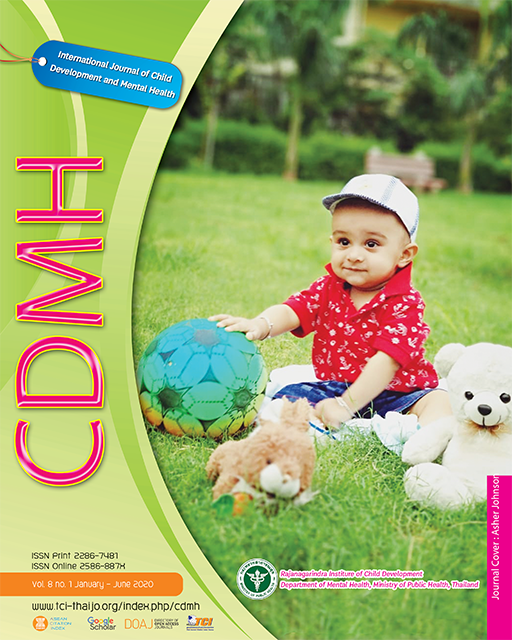Development of the Hypernasality Modification Program in Thai School-Aged Children with Cleft Lip/Palate Development of the Hypernasality Modification Program
Main Article Content
Abstract
Hypernasality with/without articulation disorders are significant speech defects among patients with Cleft Lip and/or Palate (CLP), particularly in school-aged children. Thus, there has not been a systematic program to deal with hypernasality for Thais. Therefore, this study aimed to develop a hypernasality modification program for Thai school-aged children with CLP. The hypernasality modification program in Thai school-aged children was practically developed into a systematic manual based on previous literature reviews. The program consisted of multiple steps written from one word to narrative levels, according to Thai syllable structure instruction. After completing the 1st version of the development program, content validity was determined by a panel of five experts. The hypernasality modification program showed excellent validity index (S-CVI = 0.98) and item content validity index (I-CVI = 0.8 to 1.0). After the researchers’ panel review and discussion based on the experts’ suggestions, the 2nd version was delivered for the next step in the near future. The results indicated that the hypernasality modification program was valid and could be used for Thai school-aged children with CLP. Further research will be needed to determine the effectiveness of this program.
Article Details
![]()
Creative Commons License
This work is licensed under a Creative Commons Attribution-NonCommercial-No Derivatives 4.0 International (CC BY-NC-ND 4.0)
The authors retain copyright and permit the journal the copyright of first publication
Articles, once having passed the review process and accepted for publication in the CDMH Journal, are copyrighted under the CDMH Journal, Department of Mental Health, Ministry of Public Health. Please be aware distribution of CDMH Journal content for commercial purposes without permission is expressly prohibited. However, distribution with intent to educate, advocate, or spread awareness within the general public and research communities is permitted and encouraged with the understanding that the CDMH Journal Editorial Board do not hold jurisdiction or liability for any accompanying comments, text, or information from third parties, either in favor for or against the original article’s assertions, conclusions, methodology, or content.
References
Andrews, M. L., Tardy, S. J., & Pasternak, L. G. (1984). The modification of hypernasality in young children: a programming approach. Language, Speech, and Hearing Services in Schools, 15(1), 37-43.
Chantachum, V., Lekboonyasin, O., Pradubwong, S., Pattaranit, R., & Chowchuen, B. (2017). Prevalence and trend of patients with congenital malformations of craniofacial in Srinagarind hospital in fiscal year 2005 to 2014. Journal of the Medical Association of Thailand, 100(6), 145-152.
Chowchuen, B., Thanaviratananich, S., Chichareon, V., Kamolnate, A., Uewichitrapochana, C., & Godfrey, K. (2015). A multisite study of oral clefts and associated abnormalities in Thailand: the epidemiologic data. Plastic and Reconstructive Surgery-Global Open, 3(12), e583.
Grewal, J., Carmichae, l. S. L., Ma, C., Lammer, E. J., & Shaw, G. M. (2008). Maternal periconceptional smoking and alcohol consumption and risk for select congenital anomalies. Birth Defects Research Part A: Clinical and Molecular Teratology, 82(7), 519-526.
Kuehn, D. P., & Moller, K. T. (2000). Speech and language issues in the cleft palate population: the state of the art. The Cleft palate-craniofacial journal, 37(4), 1-35.
Kummer, A. W. (2014). Speech and resonance disorders related to cleft palate and velopharyngeal dysfunction: a guide to evaluation and treatment. Retrieved from https://www.researchgate.net/profile/Ann_Kummer/publication/281641011_Speech_and_Resonance_Disorders_Perspectives_16/links/55f1f37308aef559dc493136/Speech-and-Resonance-Disorders-Perspectives-16.pdf
Pamplona, M. C., Ysunza, A., & Espinosa, J. (1999). A comparative trial of two modalities of speech intervention for compensatory articulation in cleft palate children, phonologic approach versus articulatory approach. International Journal of Pediatric Otorhinolaryngology, 49(1), 21-26.
Panamonta, O., Wiromrat, P., Wongswadiwat, Y., Chaikitpinyo, A., Panamonta, M., & Wichajarn, K. (2017). Maternal tobacco smoke exposure during pregnancy and the occurrence of orofacial clefts: a systematic review of reported meta-analyses. Journal of the Medical Association of Thailand, 100(6), 270-277.
Panamonta, V., Pradubwong, S., Panamonta, M., & Chowchuen, B. (2015). Global birth prevalence of orofacial clefts: a systematic review. Journal of the Medical Association of Thailand, 98(7), 11-21.
Peterson-Falzone, S. J., Hardin-Jones, M. A., & Karnell, M. P. (2010). Treatment of speech-language problems. In Cleft palate speech (4th ed., pp. 321-344). St. Louis: Mosby.
Prathanee, B., Lorwatanapongsa, P., Anantapong, D., & Buakanok, N. (2011). Thai speech parameters for patients with cleft palate in a universal reporting system. Asia Pacific Journal of Speech, Language and Hearing, 14(1), 31-49.
Prathanee, B., Makarabhirom, K., Pumnum, T., Seepuaham, C., Jaiyong, P., & Pradubwong, S. (2014). Khon Kaen: a community-based speech therapy model for an area lacking in speech services for clefts. The Southeast Asian Journal of Tropical Medicine and Public Health, 45(5), 1182-1195.
Prathanee, B., Pumnum, T., & Seepuaham, C. (2013). Types of articulation errors in individuals with cleft lip and palate. Journal of the Medical Association of Thailand, 96(4), 81-90.
Prathanee, B., Seepuaham, C., & Pumnum, T. (2014). Articulation disorders and patterns in children with a cleft. Asian Biomedicine, 8(6), 699-706.
Prathanee, B., Thanawirattananit, P., & Thanaviratananich, S. (2013). Speech, language, voice, resonance and hearing disorders in patients with cleft lip and palate. Journal of the Medical Association of Thailand, 96(4), 71-80.
Ray, B., & Baker, B. M. (1990). Hypernasality modification program: a systematic approach. Tucson (AZ): Communication Skill Builders.
Scherer, N. J., D'Antonio, L. L., & McGahey, H. (2008). Early intervention for speech impairment in children with cleft palate. The Cleft palate-craniofacial journal, 45(1), 18-31.


